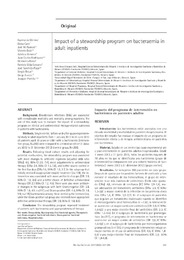Please use this identifier to cite or link to this item:
https://hdl.handle.net/11000/35441Impact of a stewardship program on bacteraemia in adult inpatients.
| Title: Impact of a stewardship program on bacteraemia in adult inpatients. |
| Authors: Torrús, Diego Merino, Esperanza CARO, ELENA Ramos, José M. Boix, Vicente Gimeno Gascon, Adelina Rodríguez, Juan Carlos Riera, Gerónima Más-Serrano, Patricio Sánchez-Paya, José Reus, Sergio Portilla, Joaquín |
| Editor: Sociedad Española de Quimioterapia |
| Department: Departamentos de la UMH::Agroquímica y Medio Ambiente |
| Issue Date: 2017 |
| URI: https://hdl.handle.net/11000/35441 |
| Abstract: Background. Bloodstream infections (BSIs) are associated with considerable morbidity and mortality among inpatients. The aim of this study was to evaluate the impact of a stewardship program on clinical and antimicrobial therapy-related outcomes in patients with bacteraemia.Methods. Single-centre, before-and-after quasi-experimen-tal study in adult inpatients. Over 1 January 2013 to 31 June 2013 all patients aged 18 years or older with a bacteraemia (interven-tion group, N=200) were compared to a historical cohort (1 Janu-ary 2012 to 31 December 2012) (control group, N=200). Results. Following blood culture results and adjusting for potential confounders, the stewardship program was associated with more changes to antibiotic regimens (adjusted odds ratio [ORa]: 4.6, 95% CI 2.9, 7.4), more adjustments to antimicrobial therapy (ORa: 2.4, 95% CI 1.5, 3.8), and better source control in the first five days (ORa 1.6, 95% CI: 1.0, 2.7). In the subgroup that initially received inappropriate empiric treatment (n=138), the in-tervention was associated with more antibiotic changes (OR: 3.9, 95% CI: 1.8, 8.5) and a better choice of definitive antimicrobial therapy (OR 2.3 95% CI: 1.2, 4.6). There were also more antibiot-ic changes in the subgroups with both Gram-negative (OR: 2.8, 95% CI: 1.6, 4.9; n=217) and Gram-positive (OR: 4.6, 95% CI: 1.8, 9.9; n=135) bacteraemia among those receiving the intervention, while the Gram-positive subgroup also received more appropriate definitive antimicrobial therapy (OR: 3.9, 95% CI: 1.8, 8.8).Conclusion: The stewardship program improved treatment of patients with bacteraemia and appropriateness of therapy. RESUMEN Introducción. Las bacteriemias están asociadas con una elevada morbilidad y mortalidad en pacientes hospitalizados. El objetivo del estudio fue evaluar el impacto de un programa de intervención clínica y de terapia antimicrobiana en pacientes con bacteriemia. Material. Estudio en un centro tipo cuasi-experimental pre y post-intervención en pacientes adultos hospitalizados. Desde 1 enero 2013 a 31 junio 2013, todos los pacientes mayores de 18 años en los que se identificaba una bacteriemia (grupo de intervención) se compararon con una cohorte histórica de bacteriemia (1 enero 2012 a 31 diciembre 2012) (grupo control). Resultados. Se incluyeron 200 pacientes en cada grupo. Después de ajustar por los posibles factores de confusión y tras conocer el resultado de los hemocultivos, el grupo de intervención tuvo más cambios de antibióticos (Odds ratio ajustada [ORa]: 4,6, intervalo de confianza [IC] 95%: 2,9-7,4), mayor adecuación del tratamiento antibiótico (ORa: 2,4, IC 95%: 1,5-3,8) y mayor control de la infección en los primeros cinco días (ORa 1,6, IC 95%: 1,0-2,7). En el subgrupo de pacientes que seguían un tratamiento inadecuado cuando se identificó el microorganismo en el hemocultivo (n =138), la intervención se asoció con un mayor cambio de antibiótico (OR: 3,9, IC 95%: 1,8-8,5) y una mejor elección final del antibiótico (OR: 2.3; IC 95%: 1.2-4.6). En el subgrupo de bacteriemia por gramnegativos (n=217), el programa de intervención en bacteriemia se asoció con un mayor cambio de antibiótico (OR: 2,8; IC 95%: 1,6-4,9) y en el subgrupo de bacteriemia por microorganismos grampositivos (n=135), el programa de intervención indujo un mayor cambio en el uso de antibióticos (OR: 4,6, IC 95%: 1,8- 9,9) y una mejor elección final del tratamiento (OR: 3,9; 95% CI: 1,8-8,8). |
| Keywords/Subjects: Stewardship Bacteraemia Therapeutic use Anti-bacterial agents Gram-negative bacterial infections Gram-positive bacterial infections Hospitalization |
| Type of document: info:eu-repo/semantics/article |
| Access rights: info:eu-repo/semantics/openAccess Attribution-NonCommercial-NoDerivatives 4.0 Internacional |
| Published in: Rev Esp Quimioter, 30(4), 257-63. |
| Appears in Collections: Artículos Agroquímica y Medio Ambiente |
.png)

